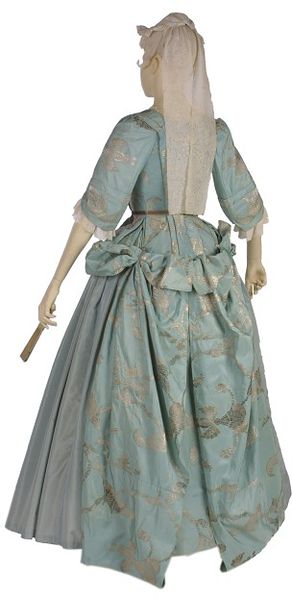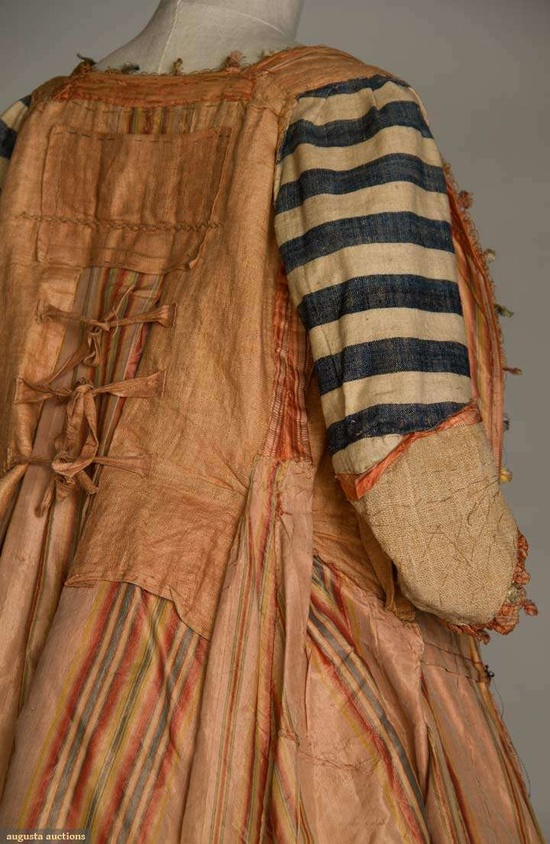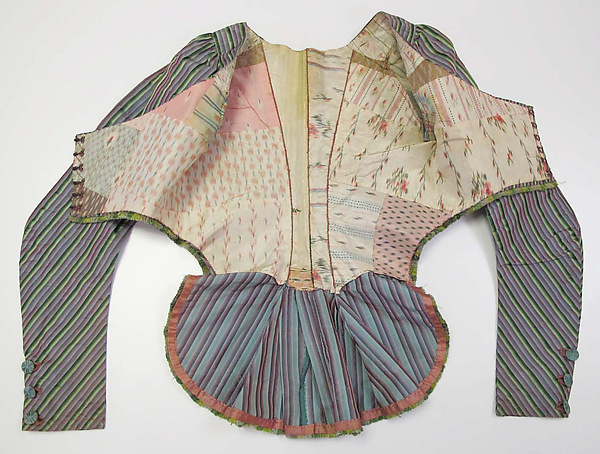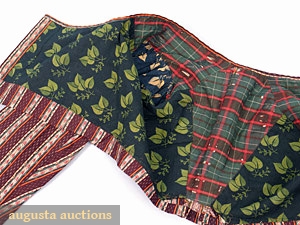Can you believe it? 10 challenge in, only 2 to go!
The theme for the Historical Sew Monthly Challenge #10 is Sewing Secrets: Hide something in your sewing, whether it is an almost invisible mend, a secret pocket, a false fastening or front, or a concealed message (such as a political or moral allegiance)
This mantua hides a secret. In order to keep the right side of the fabric facing outwards with the complicated turning and tuckings of the bustling, the fabric has been sewn right side out at places, and wrong side at others, so it only looks correct when draped and bustled:
Many sewing secrets were done to save money. Even Madame de Pompadour, whose clothing expenditure well outstripped Marie Antoinette’s, was known to have her petticoats made with cheap linen at the back of the petticoat, where it would not show, rather than the expensive silk that graced the front of the skirt.
In addition to different fabrics hidden under the skirts of dresses, many 18th and early 19th garments feature surprising lining fabrics, as seamstresses used any scraps of fabric they had at hand for pieces that were not seen:
From the outside you would never know that this jacket lining is a veritable patchwork of silk:
Or that this spencer is lined in a multitude of bright prints:
Making do has led to many a sewing secret. One of my favourites comes from Louisa May Alcott’s An Old Fashioned Girl, where Polly tells the story of how her sister got a dress out of an odd bit of fabric:
This silk reminds me of Kitty’s performance last summer. A little checked silk was sent in our spring bundle from Mrs. Davenport, and Mother said Kit might have it if she could make it do. So I washed it nicely, and we fussed and planned, but it came short by half of one sleeve. I gave it up, but Kit went to work and matched every scrap that was left so neatly that she got out the half sleeve, put it on the under side, and no one was the wiser. How many pieces do you think she put in, Maud?”
“Fifty,” was the wise reply.
“No, only ten, but that was pretty well for a fourteen-year-old dressmaker. You ought to have seen the little witch laugh in her sleeve when any one admired the dress, for she wore it all summer and looked as pretty as a pink in it. Such things are great fun when you get used to them; besides, contriving sharpens your wits, and makes you feel as if you had more hands than most people.
In the mid-19th century the full folds of women’s skirts made it easy to hide pockets in the seams and at the waist. Particularly in the 1840s & 50s, and into the first part of the 1860s, pockets tended to be very discreet and hidden, possibly as a carry-on of the earlier association of pockets as particularly feminine, and visible bags as particularly masculine. This dress features both a discreet watch pocket hidden just below the overlap of the belt, and an equally hidden larger pocket in the side seam under it.
Many late Victorian dresses feature hidden fastenings, like the lacing hiding under the false front of this evening dress which was recently featured on Rate the Dress:
Sewing secrets aren’t always about the construction of the garment: they can also be about the subtle messages conveyed through cut, colour and design. We aren’t talking about the broad, obvious messages that dress sometimes carries: the choice between Royalist or Roundhead garb in the 17th century is obvious, as is wearing a tricolour ribbon during the French Revolution. This challenge is about the smaller, much more subtle actions.
This portrait of Marie-Josephe, dauphine of France, carries two secrets. The first is her portrait bracelet: such bracelets were very common in 18th c dress, but the dauphine’s carried a portrait that would make no sense to most viewers of the time, but had a clear message for the intended recipient. Her other secret is the spray of jewelled lilies in her hair: long associated with French royalty, the flowers declare both her purity, and her loyalty to her new family. During the revolution the less common lily of the valley (rather than a full lily) as a motif was a subtler way to declare allegiance.
Sargent’s portrait of conservationist Harriet Hemenway looks conservative enough, but it caused a small scandal when it was debuted, because in the symbolism that Victorians attached to flowers the waterlily that Hemenway is tucking into her dress publicly announced that she was pregnant. Hemenway’s flower is not integral to the dress, but specific flowers on a fabric or trimming a bonnet could carry permanent messages.
There are so many ways to hide a secret in your sewing! I look forward to finding them all out next month!










Thank you so much for these insights into sewing secrets! I especially love the crazy linings – it makes so much sense to use every scrap, doesn’t it, if you think of how expensive silks were.
I have just been making a baby quilt out of various scraps, also in a “crazy” pattern, and it’s really amazing what nice effects you get if you mix, match and piece even tiny leftover pieces of fabric – and it feels so much better than to throw them away. 🙂
I remember a challenge, where one of the participants perfectly matched a checked pattern on a sleeve. It was SO cool! No one would have known, had she not told. It was gorgeous!
Maybe crazy linings can be a way to have pieces of something to remember to carry with you ? Like pieces of your mother and sisters dresses, or something like that ?
Your article was very interesting to read, thank you for sharing with us secrets that can barely be known by us, when seing a dress on internet or visiting a costume museum.
The perfectly matched up pieces – very interesting, I saw an exhibition at the Bavaria National Museum (yes, we actually have one, lucky us 🙂 ) of 18th century clothing, and there were several examples of expensive dresses made from expensive ikat fabrics where the fabric wasn’t matched up at all. And in highly visible places, too, for example the front part of the dress.
Apparently they didn’t think it necessary.
Oh, that passage about the sleeves remind me of my own Insanely Pieced Dress from the Literature Challenge in 2013 😀
Maybe it was YOUR dress that I remember. A blue-checked one? It was such a neat project.
That’s the one! It’s an amazing dress!
It’s amazing! I’m totally in awe of that dress.
Language of flowers! I didn’t think of that, but it’s quite possible all those similarly styled flower-ebroidered Regency dresses are actually sending a message…
Yay, I’ve just finished a post about my entry for this challenge–an evening dress from 1910!
https://quinnmburgess.wordpress.com/2015/10/10/hsfm-10-1910-dowager-countess-evening-gown/
Best,
Quinn
What?! 11 days BEFORE the deadline?! 😉
I just posted my entry for this month! It’s a bolero that’s secretly lined with the reverse side of the same fabric.
http://dollycreates.blogspot.com/2015/10/black-and-purple-1940s.html
I haven’t had the opportunity to participate before, but this challenge reminded me of something that I think is really important. So, here’s my contribution.
http://18thcstockholm.blogspot.se/2015/10/the-secret-date-shift.html
I made some 18th century stays! This was a really fun challenge.
https://trumpetsandtrimmings.wordpress.com/2015/11/01/18th-century-stays-hsm-10/
I’m late! But I did sew a 1940s nightgown for this challenge, because it makes total sense to sew a summer nightgown in Autumn.
http://levagabondage.blogspot.com/2015/11/hsf-challenge-sewing-secrets.html
I’m really late, but I wanted to finish! I got very close to done by end of October, but life and work interfered, so I had to ‘re-schedule’ my sewing time a few weekends. For my October HSM Sewing Secrets, I drafted and made a Regency ‘fichu’ with a hidden pocket on the inside/back for a love note!
http://theladydetalle.blogspot.com/2015/11/regency-fichu-october-hsm-challenge.html
sewhistorically.comI know I’m very late but I’ve finally finished the Victorian/ Edwardian silver dog collar for my dog. 🙂 The collar took much more time than I thought. Apart from the metal I’ve used naturally dyed black leather which I’ve dyed myself.
http://www.sewhistorically.com/silver-dog-collar-historical-sew-monthly/